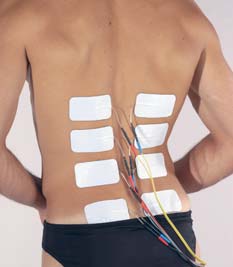Transcutaneous Electrical Nerve Stimulation (TENS) for Postoperative Pain Relief: Difference between revisions
No edit summary |
No edit summary |
||
| Line 9: | Line 9: | ||
The success of [[Transcutaneous Electrical Nerve Stimulation (TENS)|Transcutaneous Electrical Stimulation]] in the management of chronic pain along with its absence of side effects, particularly respiratory depression, has led to its recent use in the management of post-operative pain. Transcutaneous Electrical Nerve Stimulation (TENS) is an effective adjunctive therapy for postoperative pain; however, effects of different frequencies of stimulation have not been systematically investigated. | The success of [[Transcutaneous Electrical Nerve Stimulation (TENS)|Transcutaneous Electrical Stimulation]] in the management of chronic pain along with its absence of side effects, particularly respiratory depression, has led to its recent use in the management of post-operative pain. Transcutaneous Electrical Nerve Stimulation (TENS) is an effective adjunctive therapy for postoperative pain; however, effects of different frequencies of stimulation have not been systematically investigated. | ||
=== '''How Transcutaneous Electrical Nerve Stimulation is applied''' === | === '''How Transcutaneous Electrical Nerve Stimulation is applied''' === | ||
| Line 22: | Line 15: | ||
[[Category:Electrotherapy]] | [[Category:Electrotherapy]] | ||
[[Category:Transcutaneous Electrical Nerve Stimulation]] | [[Category:Transcutaneous Electrical Nerve Stimulation]] | ||
<references /> | |||
Revision as of 18:06, 16 September 2020
Original Editor - Aminat Abolade
Top Contributors - Aminat Abolade, Kim Jackson and Leana Louw
Introduction[edit | edit source]
Conventional approaches to the management of post-operative pain remains inadequate. Intermittent ‘on-demand’ administration of opiates results in fluctuating plasma levels and poor pain relief; increasing the frequency of administration and the amount of opiate may improve pain control but results in unwanted side effects. Intravenous opiate infusion may provide better analgesia but with the risk of respiratory depression.
The success of Transcutaneous Electrical Stimulation in the management of chronic pain along with its absence of side effects, particularly respiratory depression, has led to its recent use in the management of post-operative pain. Transcutaneous Electrical Nerve Stimulation (TENS) is an effective adjunctive therapy for postoperative pain; however, effects of different frequencies of stimulation have not been systematically investigated.







